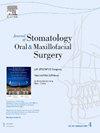利用深度学习人工智能自动检测颞下颌关节骨关节炎的影像学特征。诊断准确性研究。
IF 1.8
3区 医学
Q2 DENTISTRY, ORAL SURGERY & MEDICINE
Journal of Stomatology Oral and Maxillofacial Surgery
Pub Date : 2024-10-31
DOI:10.1016/j.jormas.2024.102124
引用次数: 0
摘要
研究目的本研究的目的是参照经验丰富的放射科医生,研究神经网络人工智能模型在颞下颌关节骨关节炎放射学确诊方面的诊断性能:在一项诊断准确性队列研究中,评估了人工智能模型在识别颞下颌关节骨关节炎患者放射学特征方面的诊断性能。研究对象包括根据颞下颌关节紊乱诊断标准决策树选择进行放射学检查的成人患者。锥形束计算机断层扫描图像由物体检测 YOLO 深度学习模型进行评估。诊断结果与检查员的放射学评估结果进行了验证:除皮质下囊肿外(P=0.049*),人工智能模型与检查者之间的差异在统计学上不显著。与检查者的数据相比,人工智能模型显示出相当接近完美的一致性。就每种放射学表型而言,人工智能模型都具有良好的灵敏度、特异性和准确性,其接收者操作特征(ROC)分析具有高度统计学意义(P < 0.001)。曲线下面积从表面侵蚀的 0.872 到皮质下囊肿的 0.911 不等:结论:人工智能物体检测模型可为颞下颌关节-颌面关节放射影像学确认和放射学特征识别提供有效、自动化和便捷的模式,并具有显著的诊断能力。本文章由计算机程序翻译,如有差异,请以英文原文为准。
Automatic detection of temporomandibular joint osteoarthritis radiographic features using deep learning artificial intelligence. A Diagnostic accuracy study
Objective
The purpose of this study was to investigate the diagnostic performance of a neural network Artificial Intelligence model for the radiographic confirmation of Temporomandibular Joint Osteoarthritis in reference to an experienced radiologist.
Materials and Methods
The diagnostic performance of an AI model in identifying radiographic features in patients with TMJ-OA was evaluated in a diagnostic accuracy cohort study. Adult patients elected for radiographic examination by the Diagnostic Criteria for Temporomandibular Disorders decision tree were included. Cone-beam computed Tomography images were evaluated by object detection YOLO deep learning model. The diagnostic performance was verified against examiner radiographic evaluation.
Results
The differences between the AI model and examiner were non-significant statistically, except in the subcortical cyst (P = 0.049*). AI model showed substantial to near-perfect levels of agreement when compared to those of the examiner data. Regarding each radiographic phenotype, the AI model reported favorable sensitivity, specificity, accuracy, and highly statistically significant Receiver Operating Characteristic (ROC) analysis (p < 0.001). Area Under Curve ranged from 0.872, for surface erosion, to 0.911 for subcortical cyst.
Conclusion
AI object detection model could open the horizon for a valid, automated, and convenient modality for TMJ-OA radiographic confirmation and radiomic features identification with a significant diagnostic power.
求助全文
通过发布文献求助,成功后即可免费获取论文全文。
去求助
来源期刊

Journal of Stomatology Oral and Maxillofacial Surgery
Surgery, Dentistry, Oral Surgery and Medicine, Otorhinolaryngology and Facial Plastic Surgery
CiteScore
2.30
自引率
9.10%
发文量
0
审稿时长
23 days
 求助内容:
求助内容: 应助结果提醒方式:
应助结果提醒方式:


